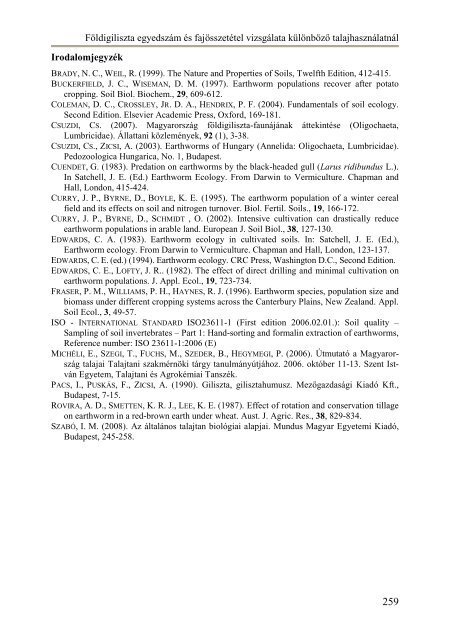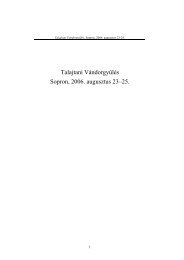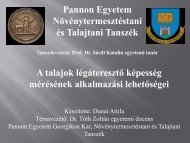- Page 1 and 2:
Különszám TALAJAINK A VÁLTOZÓ
- Page 3 and 4:
Talajvédelmi Alapítvány Elnök S
- Page 5 and 6:
Kötetszerkesztı Farsang Andrea, L
- Page 7 and 8:
Rendezık Magyar Talajtani Társas
- Page 9 and 10:
Változó talajaink 103 Balog Kitti
- Page 11 and 12:
Zsembeli József, Kovács Györgyi,
- Page 14 and 15:
ELİSZÓ A 2010. évi Talajtani Vá
- Page 16:
TALAJADATOK FELDOLGOZÁSA ÉS ÉRT
- Page 19 and 20:
Dömsödi értékszámos térképez
- Page 21 and 22:
Dömsödi A talajtérképezés sor
- Page 23 and 24:
Dömsödi lan, ill. a földrészlet
- Page 25 and 26:
Dömsödi Az alapokat a digitális
- Page 27 and 28:
Kocsis - Makó - Farsang Bevezetés
- Page 29 and 30:
Kocsis - Makó - Farsang 1. ábra A
- Page 31 and 32:
Kocsis - Makó - Farsang Vizsgálat
- Page 33 and 34:
Kocsis - Makó - Farsang nyosan sú
- Page 36 and 37:
BÁNYÁSZATI EREDETŐ NEHÉZFÉM- S
- Page 38 and 39:
Bányászati eredető nehézfém-sz
- Page 40 and 41:
Bányászati eredető nehézfém-sz
- Page 42 and 43:
Bányászati eredető nehézfém-sz
- Page 44 and 45:
A MAGYARORSZÁGI ERUBÁZ TALAJOK Á
- Page 46 and 47:
A magyarországi erubáz talajok á
- Page 48 and 49:
Tihany A magyarországi erubáz tal
- Page 50 and 51:
A magyarországi erubáz talajok á
- Page 52 and 53:
A MARTHA ADATBÁZIS ALKALMAZÁSA A
- Page 54 and 55:
A MARTHA adatbázis alkalmazása a
- Page 56 and 57:
A MARTHA adatbázis alkalmazása a
- Page 58:
A MARTHA adatbázis alkalmazása a
- Page 61 and 62:
Nagy - Nyéki - Szabó - Soltész -
- Page 63 and 64:
Nagy - Nyéki - Szabó - Soltész -
- Page 65 and 66:
Nagy - Nyéki - Szabó - Soltész -
- Page 67 and 68:
Nagy - Nyéki - Szabó - Soltész -
- Page 69 and 70:
Puskás - Farsang tekinti, melyek s
- Page 71 and 72:
Puskás - Farsang 70 • Humuszmin
- Page 73 and 74:
Puskás - Farsang Jelen esetben is
- Page 75 and 76:
Puskás - Farsang WRB (2007) által
- Page 78 and 79:
TÉRINFORMATIKAI ELEMZİ MÓDSZER K
- Page 80 and 81:
Térinformatikai elemzı módszer k
- Page 82 and 83:
Térinformatikai elemzı módszer k
- Page 84 and 85:
Térinformatikai elemzı módszer k
- Page 86 and 87:
TERMÉSZETI HÁTRÁNYOKKAL ÉRINTET
- Page 88 and 89:
Természeti hátrányokkal érintet
- Page 90 and 91:
Természeti hátrányokkal érintet
- Page 92 and 93:
Természeti hátrányokkal érintet
- Page 94 and 95:
SZEGED KÜLVÁROSI, KERTI TALAJAINA
- Page 96 and 97:
Szeged külvárosi, kerti talajaina
- Page 98 and 99:
Szeged külvárosi, kerti talajaina
- Page 100 and 101:
Szeged külvárosi, kerti talajaina
- Page 102 and 103:
Szeged külvárosi, kerti talajaina
- Page 104:
VÁLTOZÓ TALAJAINK
- Page 107 and 108:
Balog - Farsang - Czinkota fürdıb
- Page 109 and 110:
Balog - Farsang - Czinkota mértük
- Page 111 and 112:
Balog - Farsang - Czinkota 2. ábra
- Page 113 and 114:
Balog - Farsang - Czinkota között
- Page 115 and 116:
Balog - Farsang - Czinkota 3. tábl
- Page 117 and 118:
116
- Page 119 and 120:
Barna - Ladányi - Rakonczai - Deá
- Page 121 and 122:
Barna - Ladányi - Rakonczai - Deá
- Page 123 and 124:
Barna - Ladányi - Rakonczai - Deá
- Page 125 and 126:
Barna - Ladányi - Rakonczai - Deá
- Page 127 and 128:
Barna - Ladányi - Rakonczai - Deá
- Page 129 and 130:
Borcsik - Farsang - Barta - Kitka t
- Page 131 and 132:
Borcsik - Farsang - Barta - Kitka n
- Page 133 and 134:
Borcsik - Farsang - Barta - Kitka t
- Page 135 and 136:
Borcsik - Farsang - Barta - Kitka z
- Page 137 and 138:
Borcsik - Farsang - Barta - Kitka k
- Page 139 and 140:
138
- Page 141 and 142:
Jakab - Centeri - Madarász - Szala
- Page 143 and 144:
1. táblázat Parcellás erózióm
- Page 145 and 146:
Jakab - Centeri - Madarász - Szala
- Page 147 and 148:
Jakab - Centeri - Madarász - Szala
- Page 149 and 150:
148
- Page 151 and 152:
Kovács - Heil - Petı - Barczi erd
- Page 153 and 154:
Kovács - Heil - Petı - Barczi 2.
- Page 155 and 156:
Kovács - Heil - Petı - Barczi dag
- Page 157 and 158:
Kovács - Heil - Petı - Barczi A p
- Page 159 and 160:
158
- Page 161 and 162:
Markó - Labant dasági hasznosít
- Page 163 and 164:
Markó - Labant A Baranyai dombság
- Page 165 and 166:
Markó - Labant - a NO 3 -N a 2 db
- Page 167 and 168:
166
- Page 169 and 170:
Szalai et al. hatás megváltozás
- Page 171 and 172:
Szalai et al. A SOM mennyisége a l
- Page 173 and 174:
Szalai et al. 4. ábra A talajoldat
- Page 175 and 176:
Szalai et al. Következtetések Ame
- Page 177 and 178:
176
- Page 180 and 181:
A TISZÁNTÚLI SZIKES TALAJOK SZÁN
- Page 182 and 183:
A tiszántúli szikes talajok szán
- Page 184 and 185:
A tiszántúli szikes talajok szán
- Page 186 and 187:
A tiszántúli szikes talajok szán
- Page 188 and 189:
A DUNA -TISZA KÖZI LEPELHOMOK TALA
- Page 190 and 191:
A Duna - Tisza közi lepelhomok tal
- Page 192 and 193:
A Duna - Tisza közi lepelhomok tal
- Page 194 and 195:
A Duna - Tisza közi lepelhomok tal
- Page 196 and 197:
AVARKEZELÉSEK HATÁSA EGY CSERES-
- Page 198 and 199:
Avarkezelések hatása egy cseres-t
- Page 200 and 201:
Avarkezelések hatása egy cseres-t
- Page 202 and 203:
Irodalom Avarkezelések hatása egy
- Page 204 and 205:
A FAHAMU TALAJRA GYAKOROLT HATÁSÁ
- Page 206 and 207:
A fahamu talajra gyakorolt hatásá
- Page 208 and 209:
A fahamu talajra gyakorolt hatásá
- Page 210 and 211: A fahamu talajra gyakorolt hatásá
- Page 212 and 213: BIOGÁZÜZEMI FERMENTLÉ MEZİGAZDA
- Page 214 and 215: Biogáz fermentlé precíziós mez
- Page 216 and 217: Biogáz fermentlé precíziós mez
- Page 218 and 219: Biogáz fermentlé precíziós mez
- Page 220 and 221: Biogáz fermentlé precíziós mez
- Page 222 and 223: SZERVES ANYAG MANIPULÁCIÓ HATÁSA
- Page 224 and 225: Szerves anyag manipuláció hatása
- Page 226 and 227: Szerves anyag manipuláció hatása
- Page 228 and 229: Szerves anyag manipuláció hatása
- Page 230 and 231: MŐTRÁGYÁZÁS ÉS MELIORATÍV MES
- Page 232 and 233: Mőtrágyázás és melioratív mes
- Page 234 and 235: Mőtrágyázás és melioratív mes
- Page 236 and 237: Mőtrágyázás és melioratív mes
- Page 238 and 239: KUKORICA GYOMIRTÁSÁRA ALKALMAZOTT
- Page 240 and 241: Kukorica gyomírtására alkalmazot
- Page 242 and 243: Kukorica gyomírtására alkalmazot
- Page 244 and 245: Kukorica gyomírtására alkalmazot
- Page 246 and 247: A MIKORRHIZA GOMBA FOSZFOR-TÍPUS F
- Page 248 and 249: A mikorrhiza gomba foszfor-típus f
- Page 250 and 251: A mikorrhiza gomba foszfor-típus f
- Page 252 and 253: A mikorrhiza gomba foszfor-típus f
- Page 254 and 255: FÖLDIGILISZTA EGYEDSZÁM ÉS FAJÖ
- Page 256 and 257: Földigiliszta egyedszám és fajö
- Page 258 and 259: Földigiliszta egyedszám és fajö
- Page 262 and 263: ARBUSZKULÁRIS MIKORRHIZA GOMBA OLT
- Page 264 and 265: Arbuszkuláris mikorrhiza gomba olt
- Page 266 and 267: Arbuszkuláris mikorrhiza gomba olt
- Page 268 and 269: Arbuszkuláris mikorrhiza gomba olt
- Page 270 and 271: BIOGÁZ FERMENTLÉ PRECÍZIÓS MEZ
- Page 272 and 273: Biogáz fermentlé precíziós mez
- Page 274 and 275: Biogáz fermentlé precíziós mez
- Page 276 and 277: Biogáz fermentlé precíziós mez
- Page 278 and 279: A VÖRÖS CSENKESZ (FESTUCA RUBRA)
- Page 280 and 281: Anyag és módszer A vörös csenke
- Page 282 and 283: A vörös csenkesz (Festuca rubra)
- Page 284 and 285: A vörös csenkesz (Festuca rubra)
- Page 286 and 287: KOMPLEX TALAJMONITOROZÁS MINTAVÉT
- Page 288 and 289: Komplex talajmonitorozás mintavét
- Page 290 and 291: Komplex talajmonitorozás mintavét
- Page 292 and 293: Komplex talajmonitorozás mintavét
- Page 294 and 295: TALAJKÉSZLETEINK ÉS A KOR ÚJ KIH
- Page 296 and 297: Talajkészleteink és a kor új kih
- Page 298 and 299: Talajkészleteink és a kor új kih
- Page 300 and 301: Talajkészleteink és a kor új kih
- Page 302 and 303: Talajkészleteink és a kor új kih
- Page 304 and 305: Talajkészleteink és a kor új kih
- Page 306 and 307: Talajkészleteink és a kor új kih
- Page 308 and 309: A KUKORICA ÉS A CIROK VÍZFELHASZN
- Page 310 and 311:
A kukorica és a cirok vízfelhaszn
- Page 312 and 313:
A kukorica és a cirok vízfelhaszn
- Page 314:
TALAJOK ANYAGFORGALMA
- Page 317 and 318:
Balázs B. - Németh - Sipos - Szal
- Page 319 and 320:
Balázs B. - Németh - Sipos - Szal
- Page 321 and 322:
Balázs B. - Németh - Sipos - Szal
- Page 323 and 324:
Balázs B. - Németh - Sipos - Szal
- Page 325 and 326:
Barna - Simon - Tóth - Koncz -Anto
- Page 327 and 328:
Barna - Simon - Tóth - Koncz -Anto
- Page 329 and 330:
Barna - Simon - Tóth - Koncz -Anto
- Page 331 and 332:
330
- Page 333 and 334:
Dunai - Makó GERSTL et al., 1994;
- Page 335 and 336:
Dunai - Makó 1. táblázat A kís
- Page 337 and 338:
Dunai - Makó 5. ábra Az azonos ta
- Page 339 and 340:
338
- Page 341 and 342:
Farsang - Kitka - Barta nem megfele
- Page 343 and 344:
Farsang - Kitka - Barta összes és
- Page 345 and 346:
Farsang - Kitka - Barta 344 4. ábr
- Page 347 and 348:
Farsang - Kitka - Barta Az elemelmo
- Page 349 and 350:
Farsang - Kitka - Barta Köszönetn
- Page 351 and 352:
350
- Page 353 and 354:
Fuchs - Gál - Michéli Széles kö
- Page 355 and 356:
Fuchs - Gál - Michéli 0 SOM (%) 0
- Page 357 and 358:
Fuchs - Gál - Michéli KOVDA, I.,
- Page 359 and 360:
Henzsel A növényeken a magnézium
- Page 361 and 362:
Henzsel 70 60 SZD 5%=16,14 mg/kg 50
- Page 363 and 364:
Henzsel felhasználva. A legnagyobb
- Page 365 and 366:
Hernádi - Makó 364 P o = P w * [
- Page 367 and 368:
Hernádi - Makó értékek és mér
- Page 369 and 370:
Hernádi - Makó A különbözı be
- Page 371 and 372:
Hernádi - Makó BOUMA, J. (1989).
- Page 373 and 374:
Illés - Nyéki - Szabó - Szıllı
- Page 375 and 376:
Illés - Nyéki - Szabó - Szıllı
- Page 377 and 378:
Illés - Nyéki - Szabó - Szıllı
- Page 379 and 380:
Juhász - Bidló - Ódor - Heil - K
- Page 381 and 382:
Juhász - Bidló - Ódor - Heil - K
- Page 383 and 384:
Juhász - Bidló - Ódor - Heil - K
- Page 385 and 386:
Kádár helyet foglalja el a földk
- Page 387 and 388:
Kádár A talajba adott Se mintegy
- Page 389 and 390:
Kádár Amint a 6. táblázatban l
- Page 391 and 392:
390
- Page 393 and 394:
Nagy - Makó koncentrációnál (CM
- Page 395 and 396:
Nagy - Makó A tenzidoldatok koncen
- Page 397 and 398:
Nagy - Makó 4. ábra:A kontroll é
- Page 399 and 400:
Nagy - Makó ERLEI, K. (1997). Nemi
- Page 401 and 402:
Nagy - Sipos - Sándor - Nyéki - S
- Page 403 and 404:
Nagy - Sipos - Sándor - Nyéki - S
- Page 405 and 406:
Nagy - Sipos - Sándor - Nyéki - S
- Page 407 and 408:
Ragályi - Kádár felvetették, ho
- Page 409 and 410:
Ragályi - Kádár 408 1. tábláza
- Page 411 and 412:
Ragályi - Kádár hatóanyagai neh
- Page 413 and 414:
412
- Page 415 and 416:
Rékási - Filep element in the soi
- Page 417 and 418:
Rékási - Filep Eredmények és é
- Page 419 and 420:
Rékási - Filep Az NH 4 NO 3 -oldh
- Page 421 and 422:
Rékási - Filep CSATHÓ, P. (1994)
- Page 423 and 424:
Simon - Szabó - Varga - Uri - Bán
- Page 425 and 426:
Simon - Szabó - Varga - Uri - Bán
- Page 427 and 428:
Simon - Szabó - Varga - Uri - Bán
- Page 429 and 430:
Simon - Szabó - Varga - Uri - Bán
- Page 431 and 432:
Simon - Szabó - Varga - Uri - Bán
- Page 433 and 434:
Uri - Simon nehézfém-tartalmábó
- Page 435 and 436:
Uri - Simon MSZ-08-1783-20:1984, Pb
- Page 437 and 438:
Uri - Simon 2. táblázat A kontrol
- Page 439 and 440:
Uri - Simon LAVADO, R. S., RODRIGUE
- Page 441 and 442:
Kiss Klaudia 167 Kitka Gergely 127,






